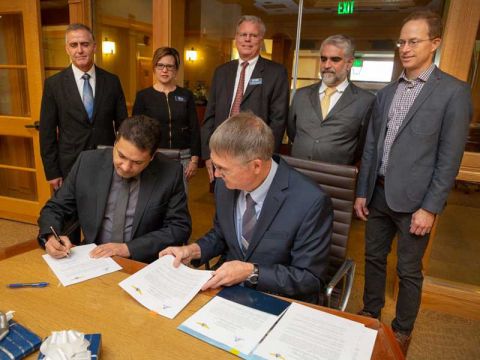
Two global leaders in aerospace engineering education are joining forces. Administrators from Utah State University and Brazil’s Instituto Tecnológico de Aeronáutica, or ITA, (Technical Aeronautics Institute) located in São Jose dos Campos in the state of São Paulo, signed a memorandum of understanding on Aug. 6 to coordinate research efforts and exchange scientific knowledge.
The document, signed by USU’s President Noelle Cockett and ITA’s Rector Anderson Ribiero Correia, kicks off a five-year partnership. USU Provost Francis D. Galey led the signing event. University leaders say the arrangement provides a unique opportunity for the two organizations to pursue joint research and exchange faculty and students.
“We are pleased to have completed this agreement of cooperation with ITA of Brazil,” said USU’s Galey. “It’s our hope the agreement will help further the work being accomplished by our collaborating faculty members.”
USU’s relationship with ITA goes back several years. Charles Swenson, a USU professor of electrical engineering and director of the USU Center for Space Engineering, has worked with many of Brazil’s science and space agencies. His ongoing research into space weather and its effects on global communication and navigation is particularly valuable to Brazil.
Equatorial regions including Northern Brazil and Peru are susceptible to an upper atmospheric phenomenon that disrupts GPS and radio communications: equatorial plasma bubbles that produce scintillation on radio waves.
Swenson is the deputy principal investigator on a Joint NASA-Brazil CubeSat mission to study the problems and potential solutions. According to a NASA press release about the upcoming mission, the Scintillation Prediction Observations Research Task (SPORT) mission, will observe equatorial plasma bubbles and scintillation to understand what causes them, determine how to predict their behavior and assess ways to mitigate their effects.
“SPORT is the first of what we hope are many joint space projects between the U.S. and Brazil,” said Swenson. “And we are pleased to be able to contribute our expertise in CubeSats and to provide the critical space weather probes for the SPORT mission.”
The joint U.S.-Brazilian team will launch the SPORT CubeSat in 2019. The compact satellite is about the size of two loaves of bread. It will be launched to an Earth orbit approximately 217-248 miles high (350-400 km). Its operational phase is expected to last at least a year.
Writer: Matt Jensen
Fonte: Utah State University (http://www.usu.edu/today/?id=57874)